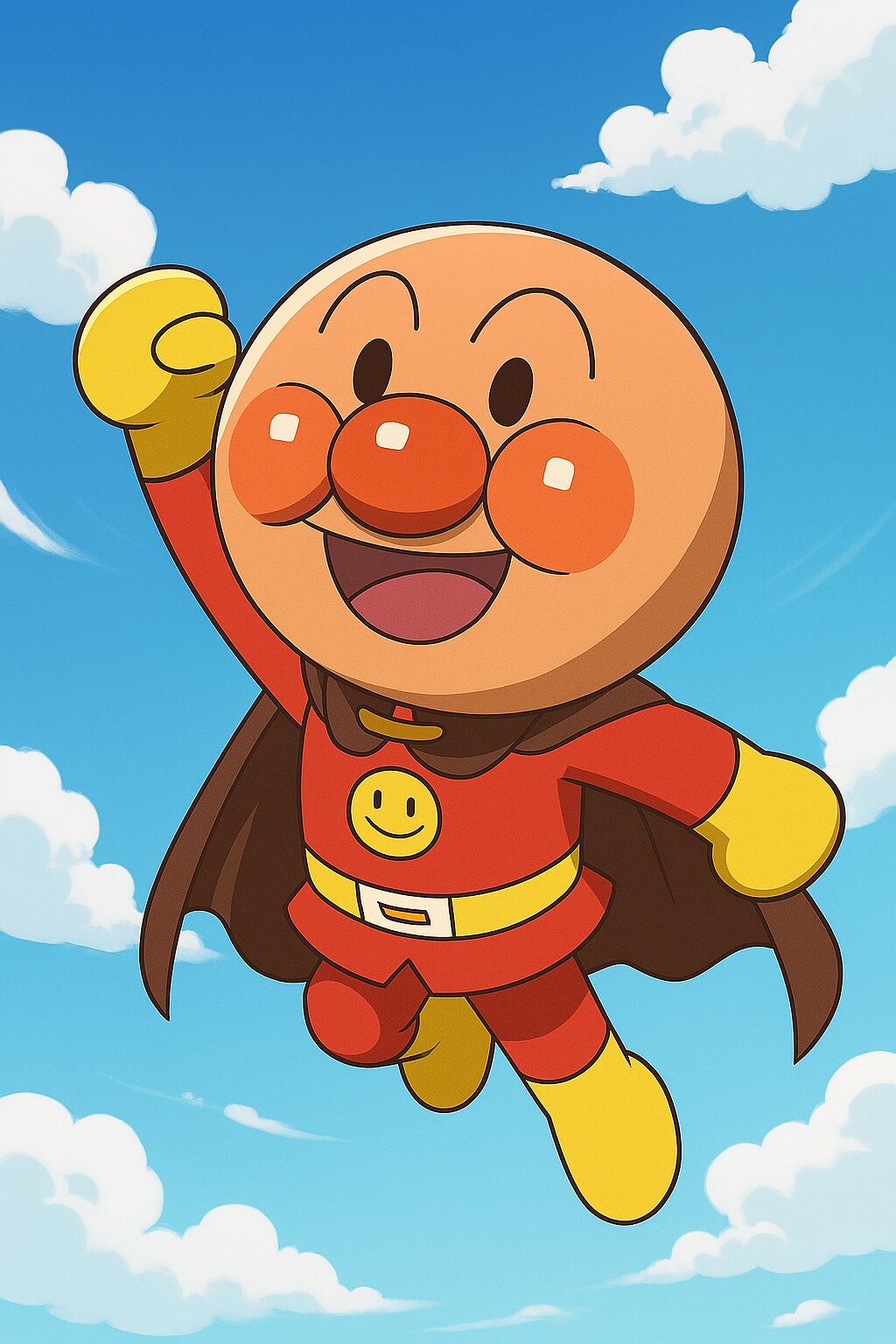- Introduction: The First Hero Japanese Children Meet
- History and Origins
- The World of Anpanman: Food and Compassion
- Why Is Anpanman So Popular in Japan?
- Anpanman as a Cultural Bridge
- Connections to Japanese Culture
- October 3: Anpanman Day
- Conclusion: A Hero Who Shares More Than Bread
- はじめに:日本の子どもたちが最初に出会うヒーロー
- アンパンマンの誕生と歴史
- アンパンマンの世界観:食べ物と優しさの融合
- なぜアンパンマンは日本でこれほど人気なのか?
- 海外から見たアンパンマン:文化の架け橋として
- アンパンマンと日本文化のつながり
- 10月3日は「アンパンマンの日」
- まとめ:アンパンマンは世界に優しさを届ける文化大使
Introduction: The First Hero Japanese Children Meet
In Japan, there’s a unique superhero named Anpanman. He flies through the sky, helps those in need, and even offers parts of his own face to feed the hungry. His face is made of sweet red bean bread called “anpan.”
To international readers, this may sound strange. But Anpanman is more than a children’s cartoon—he’s a symbol of kindness, courage, and the values deeply rooted in Japanese culture.
History and Origins
Anpanman was created by Japanese author Takashi Yanase in 1973. The animated TV series Soreike! Anpanman (“Let’s Go! Anpanman”) began airing on October 3, 1988, and has been beloved by children for over 35 years.
The show is famous for introducing new characters every week. With over 2,000 characters, it holds a Guinness World Record for the most characters in an animated series.
Official Anpanman Website (Japanese)
Yanase Takashi Memorial Museum & Anpanman Museum (Kochi Prefecture)
The World of Anpanman: Food and Compassion
In Anpanman’s universe, food-based characters are central. The hero himself is baked by Jam Uncle, and he shares pieces of his face to help those in need. This act represents self-sacrifice, sharing, and empathy—core values in Japanese society.
The antagonist, Baikinman (“Germ Man”), is mischievous and destructive, yet oddly lovable. Their battles are less about good vs. evil and more about learning to coexist with differences.
Why Is Anpanman So Popular in Japan?
- Educational Value: The show teaches kindness, bravery, and empathy. It avoids violence and is safe for preschool audiences.
- Relatable Characters: Anpanman, Currypanman, Shokupanman, and Melonpanna are all based on familiar foods, making them easy for children to connect with.
- Diversity and Inclusion: The show features characters of all ages, abilities, and backgrounds, promoting the message “Everyone is different, and that’s okay.”
Anpanman as a Cultural Bridge
While not widely known in the West, Anpanman has gained popularity in parts of Asia, including Korea and Taiwan. Tourists visiting Japan often explore Anpanman museums, and merchandise is available internationally.
The philosophy behind Anpanman—selflessness and kindness—resonates across cultures and religions. These are universal values that transcend borders.
Connections to Japanese Culture
- Sharing and Hospitality: Giving away parts of his face reflects Japan’s tradition of “osusowake” (sharing) and “omotenashi” (hospitality).
- Seasonal Imagery: The show often features Japan’s four seasons and traditional festivals, subtly introducing cultural elements.
- Food Education: By using food-based characters, the show teaches children about nutrition and the importance of meals.
October 3: Anpanman Day
October 3 marks the anniversary of the anime’s first broadcast in 1988. While not an official holiday, fans celebrate it as “Anpanman Day.” Social media posts and themed events often appear around this date.
Conclusion: A Hero Who Shares More Than Bread
Anpanman is not just a cartoon character—he’s a cultural ambassador of Japan. His stories carry messages that touch both children and adults. Through his gentle heroism, Anpanman teaches us that kindness is the greatest superpower.
If you ever visit Japan, take a moment to explore Anpanman’s world. You might discover not only a beloved character, but also a deeper understanding of Japan’s heart.
Related Links
🍞アンパンマンって誰?──世界に優しさを届ける日本のヒーロー
はじめに:日本の子どもたちが最初に出会うヒーロー
日本には「アンパンマン」という、世界でも類を見ないほどユニークで優しいヒーローがいます。彼は空を飛び、困っている人を助け、そして自分の顔を分け与えることで飢えた人々を救います。しかもその顔は、あんこ(甘い小豆ペースト)が詰まったパンでできているのです。
この設定だけでも、海外の読者には驚きかもしれません。しかし、アンパンマンは単なる子ども向けアニメではありません。彼の物語には、深い哲学、道徳、そして日本文化の価値観が込められています。
アンパンマンの誕生と歴史
アンパンマンは、絵本作家・やなせたかし氏によって1973年に初めて登場しました。テレビアニメ『それいけ!アンパンマン』は1988年10月3日に放送開始され、以来35年以上にわたり日本の子どもたちに愛され続けています。
このアニメは、毎週新しいキャラクターが登場することで知られ、登場キャラクターは2000体以上とも言われています。これはギネス記録にも認定されており、世界最多のキャラクター数を誇るアニメ作品です。
アンパンマンの世界観:食べ物と優しさの融合
アンパンマンの世界では、食べ物がキャラクターの中心です。主人公のアンパンマンは、ジャムおじさんによって焼かれた「アンパンの顔」を持ち、困っている人に自分の顔をちぎって与えます。これは「自己犠牲」「分かち合い」「助け合い」といった日本的な価値観を象徴しています。
敵キャラクターの「ばいきんまん」は、いたずら好きで破壊的ですが、どこか憎めない存在。彼との戦いは、善と悪の対立というよりも、違いを認め合う共存の物語でもあります。
なぜアンパンマンは日本でこれほど人気なのか?
- 教育的価値:「優しさ」「勇気」「思いやり」を教える教材のような存在。暴力的な描写が少なく、安心して見せられる内容。
- 親しみやすいキャラクター:アンパン、カレーパンマン、しょくぱんまんなど、食べ物をモチーフにしたキャラクターが多数登場。
- 多様性と包容力:障がいを持つキャラクターや、年齢・性別・種族を超えた存在が登場し、「みんな違って、みんないい」というメッセージを体現。
海外から見たアンパンマン:文化の架け橋として
アンパンマンは、海外ではまだ知名度が高いとは言えませんが、近年ではアジア圏を中心に人気が広がっています。特に韓国や台湾ではグッズや絵本が販売されており、日本旅行中にアンパンマンミュージアムを訪れる外国人観光客も増えています。
また、アンパンマンの哲学は、宗教や文化の違いを超えて共感を呼ぶ力があります。自己犠牲や思いやりは、どの国でも尊ばれる価値だからです。
アンパンマンと日本文化のつながり
- おすそわけ文化:顔を分け与える行為は、日本の「おすそわけ」や「もてなし」の精神に通じます。
- 季節感のある描写:四季折々の風景が描かれ、日本の自然や行事がさりげなく紹介されます。
- 食育の要素:食べ物のキャラクターを通じて、子どもたちに食の大切さを伝えています。
10月3日は「アンパンマンの日」
1988年10月3日にテレビアニメが放送開始されたことから、この日は「アンパンマンの日」とされています。日本では公式な記念日ではありませんが、ファンの間では特別な日として親しまれています。
この日には、SNSで「#アンパンマンの日」のタグが使われたり、アンパンマン関連のイベントが開催されたりすることもあります。
まとめ:アンパンマンは世界に優しさを届ける文化大使
アンパンマンは、単なるアニメキャラクターではなく、日本文化の象徴であり、優しさと思いやりを世界に伝える存在です。彼の物語には、子どもだけでなく大人にも響くメッセージが込められています。
日本を訪れる際には、ぜひアンパンマンの世界に触れてみてください。そして、アンパンマンの物語を通じて、日本の心に少し近づけるかもしれません。



コメント